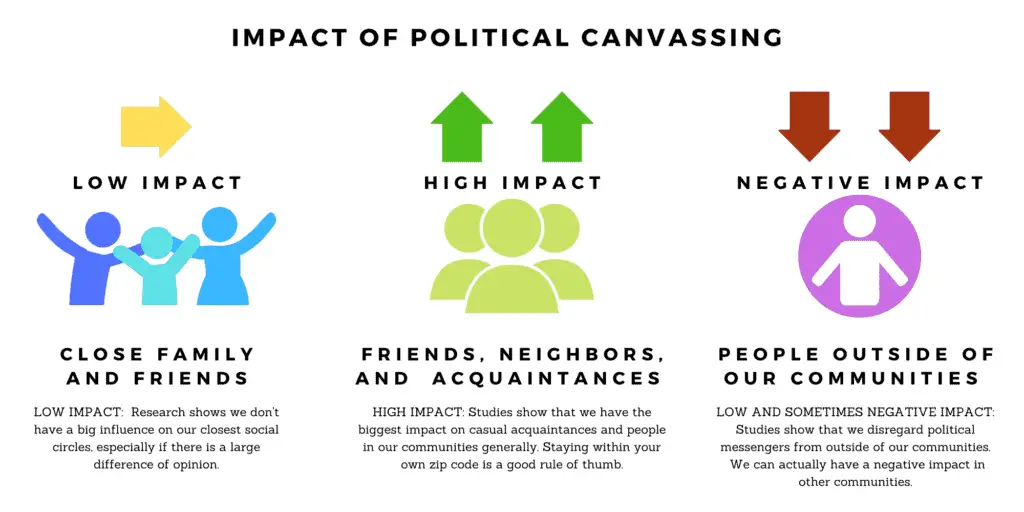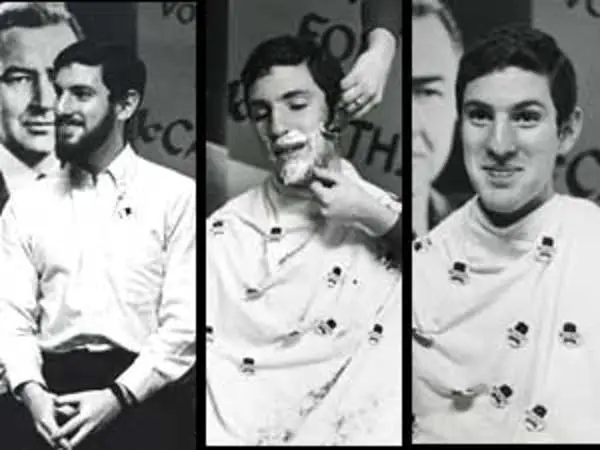
Most people who consider volunteering for a political campaign or voter registration drive ask themselves “would I really have an impact?”
Fortunately, many studies have been done on this topic with important conclusions.
Research shows that volunteer canvassers increase voter turnout and that unlikely voters can be convinced to vote from encounters with volunteers. Canvassing is most effective in one’s own community, though; volunteers who are too dissimilar to those they are canvassing can have a negative impact.
This last point is important – volunteers can actually dissuade people from voting for a candidate if they are too ideologically or demographically different from those they are canvassing.
Below is a deeper look at how we can have a positive impact, who we have a chance of impacting, and what happens when we take our message outside of our communities.
Volunteer Impact: Knowing How To Have a Positive Impact
In 2000, a landmark study showed that the type of engagement volunteers have with the general population can determine how people respond to campaigns.
Researchers looked at the impact on voter turnout of three common types of volunteer outreach – face-to-face interaction, direct mail, and phone calls.
Hands down the most effective form of engagement is face-to-face interaction. In fact, studies going back to the 1930s have shown that face-to-face interaction can impact if and how people vote.
While little is known as to why in-person encounters are so effectual versus other forms of outreach, it’s safe to say that people-to-people engagement is the best method to increase voter turnout.
The landmark study linked above showed that face-to-face encounters can increase voter turnout by about 10 – 13% (depending on what statistical methods are used to examine the data).
That’s significant. 10 – 13% is usually a big gap in political races.
The 2000 study even went so far as to suggest that there is a certain segment of the population that simply doesn’t vote – unless they are encouraged by face-to-face interaction. Political trends do change over time, though, and it’s difficult to say whether this remains true.
Nonetheless, the power of in-person engagement is an important point to keep in mind as campaigns increasingly rely on social media ads and other impersonal forms of communication.
The second most impactful method is direct mail. While direct mail can’t compare to the power of face-to-face conversations, it has been shown to increase voter turnout.
One important factor in direct mail campaigns is how many times people receive mail from the same campaign.
The study mentioned above shows that the probability of someone voting goes up by about 0.6% for every piece of mail they receive.
While the impact of each piece of direct mail may seem marginal, professional campaigns usually send about four to nine mailings.
The full impact of well-conducted mail campaigns, then, can be enough to increase turnout by a few critical percentage points.
Researchers concluded in the paper above that a campaign of only three mailings was enough to increase voter turnout by 2.5 percentage points.
That’s critical – political victories can be made around the margins with tried and true tactics like mail campaigns.
Personally, I support the use of direct mailers simply because I know that I myself have been prompted to vote on ballot measures from the constant reminders in the mail.
To me, mail is less annoying than a phone call and a good way to get an issue in front of someone.
That brings us to the last and, perhaps, the worst way of engaging would-be voters – phone calls.
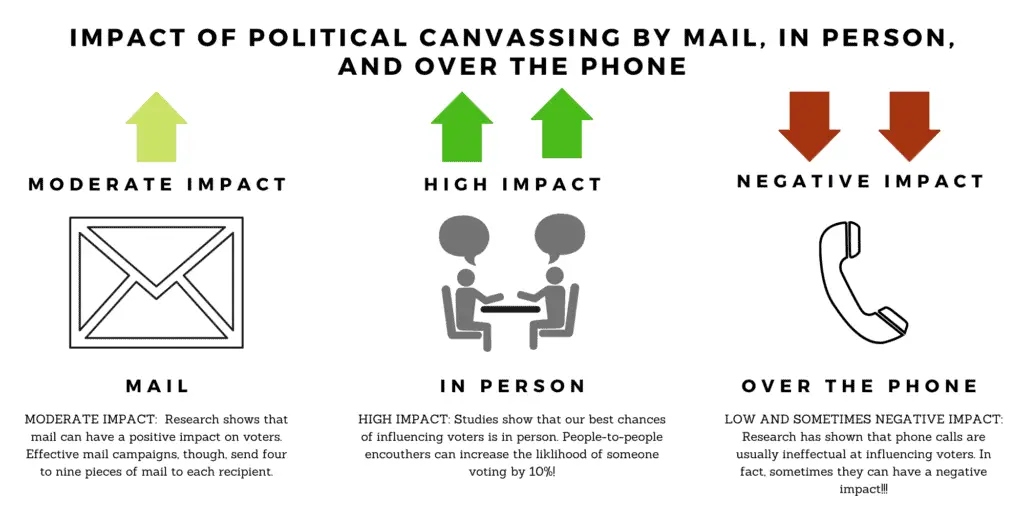
Not many people like receiving solicitations via phone calls. There is something about being interrupted by an unknown number that is an automatic turnoff. The landmark study discussed above reflects this sentiment.
The
While this fact may be disappointing to many (especially for volunteers who pour in long hours making phone calls), phone banks have been an excellent training ground for volunteers as they push through phone calls filled with rejection, unexpected situations, and the occasional long-winded conversation.
You may be wondering about the impact of social media messaging on politics. Because that’s such a big topic (and not usually an assigned duty of a volunteer), we’ve dedicated a separate post to the issue. See The Impact of Social Media on Politics for more.
Despite the many forms of communication we have today, though, people still respond best to campaigns when volunteers are there in-person.
Jim Messina, election guru known for his role in the Obama campaigns, captured this idea well in an interview with the Missoulian stating:
“But what is more important – and our research clearly showed this – is at the end what your friends and family and neighbors all said and thought about politics to you mattered more than all that stuff [referring to media campaigns].”
Volunteer Impact: Knowing Who To Canvass
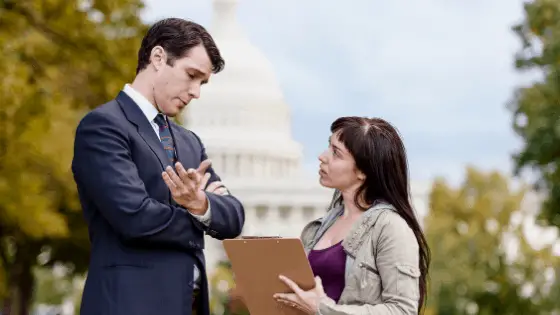
An often overlooked aspect of canvassing, even in the most sophisticated campaigns, is who volunteers are best suited to influence.
Volunteers should not make the mistake that the more people they speak with the better.
Campaigns would be best served by volunteers who strategically use their efforts rather than simply engaging with anyone and everyone they come across.
As stated above, studies have shown that volunteers are best suited to influence those in their communities. Perhaps counterintuitively, though, is that within our communities we are less likely to influence our closest friends and family.
That should come as some relief to those who want to make a difference and feel obligated to advocate to loved ones.
Research shows that we may not be well-placed to change the minds of our closest friends and family on politics. In a study that conducted interviews with 2,400 people, researchers found that subjects had a far higher ability to influence casual acquaintances on candidate choice than they did with close friends.
The study concluded that people who share a common “life space” are most strategically located to influence political choices. Close friends, however, have a weaker impact on political preferences.
If you’d like to have the biggest impact and not strain relationships, it’s best to focus your efforts on more casual contacts.
For example, the people we can influence best are the people we know casually like our local barista who knows our latte order but not our last name.
Or, the person we chat with on our morning commute who knows where we work but now where we grew up.
Beyond these more casual relationships, we can also have a big impact on complete strangers within our community.
While canvassing strangers outside of our demographics can be counterproductive (see below), people within your community will share important traits no matter their age, sex, race, etc.
A good rule of thumb is to stay within your zip code. For some volunteers, staying within your zip code may be arbitrary and you will know best the boundaries of your community but, keep in mind, the more local the better.
Volunteer Impact Outside of Our Communities
It’s important to note that our impact diminishes and can even harm a campaign if we engage with people who are too far outside of our communities.
Campaigns can and have hurt their own chances by utilizing out-of-state volunteers who are too dissimilar to the local ideologies and/or demographics.
Research has shown that people will very quickly assess the characteristics of a political messenger; if they judge a messenger to be too dissimilar from themselves, they will either discount or reject their message entirely.
This point of how we judge messengers and context has manifested in political campaigns over the decades.
Most famously, Eugene McCarthy’s presidential campaign in 1968 attracted scores of ‘hippie’ youths.
In an effort to make them better messengers for the moderate electorate, the McCarthy campaign developed a culture of clean-cut, well-shaved, well-dressed young adult canvassers. The cultural shift prompted the slogan ‘Get Clean for Gene’ among volunteers (who really did change their appearance to be better messengers).
Similarly, Ron Paul’s 2012 campaign was known for its list of strict rules for volunteers which included telling volunteers to cover tattoos, dress in business casual, and not to use social media.
The rules were an attempt to strictly control the message being conveyed and to eliminate any interference from the messengers themselves.
In the context of elections, people seem to have a narrow window for acceptable messengers. So narrow that research suggests it’s not a good idea to cross state boundaries with the intention of canvassing locals.
A groundbreaking 2015 study demonstrated this point perfectly. R
What they found was that it didn’t matter whether out-of-state volunteers spoke to locals in-person or over the phone, their message fell on deaf ears.
In some cases, the volunteers may have turned voters off to voting for Obama.
Volunteers, then, should refrain from trying to directly persuade undecideds or would-be voters outside of their communities.
How or why out-of-state volunteers are so ineffectual will likely be the subject of future research, but volunteers themselves should not feel completely powerless.
Out-of-state volunteers may have a more positive impact by direct mail campaigns or by mobilizing existing supporters in other states to canvass their communities.
Volunteers, ‘Know Thy Self’ & ‘To Thine Own Self Be True’
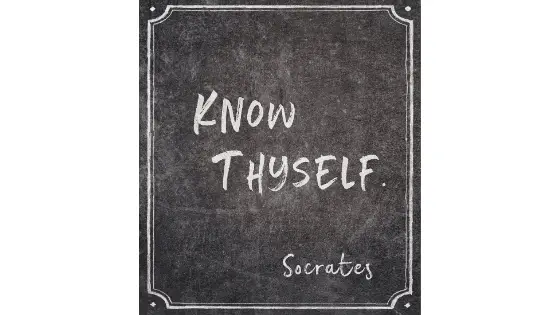
Volunteers dedicate a lot of time, energy, and things like gas money to lend a hand; they are going the extra mile to get involved, which means that they are not typical voters.
The 2015 study linked above shows that volunteers are distinct from the average population in several ways.
Volunteers tend to be more ideological and issue-driven than the general electorate. Demographically, volunteers tend to be white, middle-income, and college
Volunteers should be mindful, then, that the very act of volunteering puts them in a special category of voters and that they may have key demographic differences from the general population.
As discussed above, the differences between the volunteer and the general electorate may be reflected in how volunteers deliver messages to would-be voters.
With regard to the ideological gap, volunteers should bear in mind t
The demographic gap may be a bigger obstacle to overcome than the ideological gap.
However, with the information discussed above, volunteers have a few key strategies for having the biggest impact:
- Focus on in-person and mail campaigns (not phone calls).
- Canvass locally. Remember to:
1) stay within your zip code/community,
2) speak with friendly neighbors and associates,
3) if you’re close friends and family disagree with you politically, refrain from canvassing them. - Use mailings for out-of-state campaigns.
- Mobilize existing supporters in other locations to canvass their communities.
Ready to volunteer? Check out our post on how to volunteer to learn more and get an idea of what to expect as a volunteer.

